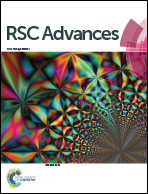Improved shape memory performance of star-shaped POSS-polylactide based polyurethanes (POSS-PLAUs)†
Abstract
Star-shaped polyhedral oligomeric silsesquioxane multi-arm polylactides (POSS-PLA) with various arm lengths were synthesized by ring opening polymerization of D,L-lactide. Then, the star-shaped POSS-PLA based polyurethanes (POSS-PLAUs) were synthesized by cross-linking POSS-PLAs with various PLA arm lengths and polytetramethylene ether (PTMEG) with hexamethylene diisocyanate (HDI). Fourier transform infrared spectroscopy (FTIR) and nuclear magnetic resonance (NMR) were utilized to characterize the structures of the materials. Differential scanning calorimetry (DSC) experiments were carried out to investigate the glass transition temperature (Tg) of POSS-PLAUs and crystallinity of PTMEG. Dynamic mechanical analysis (DMA) and stress relaxation experiments were used to study the dynamic mechanical properties and stress relaxation behaviors of POSS-PLAUs. Cyclic thermal mechanical and physical shape recovery tests were used to study the shape memory properties. The effects of POSS and PLA arm length on the mechanical, thermal properties and the shape memory behaviors were investigated. In our system, PLA arm length has no significant effect on glass transition temperature (Tg). Tg increases with the POSS content in the networks due to the obstructed movement of the polymer chains caused by caged POSS. E′ increases from POSS-PLAU110 to POSS-PLAU530 due to the decreasing of PTMEG content. Dynamic mechanical analysis reveals a similar relationship of glass transition temperature to POSS content. The stress relaxation curves show an increase in initial stress in POSS-PLAUs with longer arm length due to lower PTMEG content. The relaxation ratio is higher for the polymer with shorter PLA arm length. The quick relaxation above the triggering temperature of POSS-PLAU with shorter PLA arm length is favorable for quick shape recovery. All the POSS-PLAUs have excellent shape memory properties with high shape fixity ratios above 99%, shape recovery ratios around 84% for the first cycle and above 89% for the second cycle. POSS-PLAUs with the shorter arm length show faster recovery speed due to the higher content of POSS cores.


 Please wait while we load your content...
Please wait while we load your content...